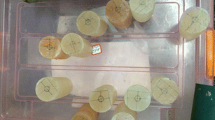Abstract
In this study, an ordinary differential equation for dissolution of rock salt in still water is established, for the purpose of researching the dissolution mechanism of rock salt in still water, by calculating the concentration distribution of the boundary layer of the rock salt solution. On this basis, a dissolution model for rock salt in still water with different dissolution areas, solution concentrations, and solution temperatures is established. The corresponding analytical solutions are derived and solved, and parameter inversion is conducted with experimental data on rock salt dissolution, from which the dissolution parameter convective mass transfer coefficient k in still water is obtained. In addition, the results of previous dissolution tests are interpreted and discussed from a theoretical perspective using the derived dissolution model. It is found that the dissolution area has no obvious influence on the dissolution rate and the dissolution rate gradually decreases with increasing solution concentration when the solution volume is 5 L and the water is changed every 5 min. It is also proved that parameter a1 is relevant to the molar mass M and saturation concentration Cs, and parameter a2 is relevant to the convective mass transfer coefficient k. The model established in this paper may describe well the dissolution mechanism of rock salt in still water, and provides a basic theoretical foundation and analytical method for research on the dissolution characteristics of rock salt.









Similar content being viewed by others
References
Anderson NL, Hinds RC (1997) Glacial loading and unloading: a possible cause of rock salt dissolution in the western Canada basin. Carbonates Evaporites 12(1):43–52
Cosenza P, Ghoreychi M, Bazargan-sabet B, de Marsily G (1999) In situ rock salt permeability measurement for long term safety assessment of storage. Int J Rock Mech Min Sci 36(4):509–526
Cuevas CL (1997) Pore structures characterization in rock salt. Eng Geol 47:17–30
Durie RW, Jessen FW (1964) Mechanism of the dissolution of salt in the formation of underground salt cavities. Soc Petrol Eng J 4(2):183–190. https://doi.org/10.2118/678-PA
Fairchild IJ, Killawee JA, Hubbard B, Dreybrodt W (1999) Interactions of calcareous suspended sediment with glacial meltwater: a file test of dissolution behaviour. Chem Geol 155:243–263
Liang WG, Zhao YS, Xu SG, Dusseat MB (2008) Dissolution and seepage coupling effect on transport and mechanical properties of glauberite salt rock. Transport Porous Med 74(2):185–189
Liu CL (2000) Study on the physicochemical characteristics and cavity form of drilling water dissolving for thin-layer salt rock. Dissertation, Chongqing University. (in Chinese)
Liu CL, Xu LJ, Xian XF (2002) Fractal-like kinetic characteristics of rock salt dissolution in water. Colloid Surface A 201(1–3):231–235
Liu XR, Yang X, Zhong ZL, Liang NH, Wang JB, Huang M (2015) Research on dynamic dissolving model and experiment for rock salt under different flow conditions. Adv Mater Sci Eng 2015:1–10. https://doi.org/10.1155/2015/959726
Mokni N, Olivella S, Li XL, Smets S, Valcke E (2008) Deformation induced by dissolution of salts in porous media. Phys Chem Earth 33:436–443
Spangenberg E, Spangenberg U, Heindorf C (1998) An experimental study of transport properties of porous rock salt. Phys Chem Earth 23(3):367–371
Stormont JC (1997) In situ gas permeability measurements to delineate damage in rock salt. Int J Rock Mech Min Sci 34(7):1055–1064
Tsang CF, Bemier F, Davies C (2005) Geohydromechanical processes in the excavation damaged zone in crystalline rock, rock salt, and indurated and plastic clays-in the context of radioactive waste disposal. Int J Rock Mech Min Sci 42(1):109–125
Voznesenskii AS, Ertuganova EA, Vli’yamov SV, Tavostin MN (2006) Studying the mechanism of acoustic emission in failure of rock salt by dissolving. J Min Sci 42(1):35–42
Wang QM (2003) Solution mining of salt deposit. Chemical Industry Press, Beijing (in Chinese)
Wang CR (2009) Experimental study of the influencing factors on dissolution rate of rock salt. Dissertation, Chongqing university. (in Chinese)
Xu SG, Liang WG, Zhao YS (2005) Experimental study on dissolution characteristics of glauberite of rock salt. J Taiyuan Univ Technol 36(6):243–244 (in Chinese)
Yang CH, Jing WJ, Daemen JJK, Zhang GM, Du C (2013) Analysis of major risks associated with hydrocarbon storage caverns in bedded salt rock. Reliab Eng Syst Saf 113:94–111
Zechner E, Konz M, Younes A, Huggenberger P (2011) Effects of tectonic structures, salt solution mining, and density-driven groundwater hydraulics on evaporite dissolution (Switzerland). Hydrogeol J 19:1323–1344
Zhao ZC (2003) Theory of fluid transportation and configuration development in solution mining cavern for underground gas storage. Dissertation, Percolation mechanics research institute of Chinese academy of sciences. (in Chinese)
Zhao ZC, Zhu WY, Shan WW, Wan YJ (2000) Research on mechanism of solution mining for building underground gas storage in salt cavern. Pet Explor Dev 30(5):107–109 (in Chinese)
Zidane A, Zechner E, Huggenberger P, Younes A (2014) Simulation of rock salt dissolution and its impact on land subsidence. Hydrol Earth Syst Sci 18:2177–2189
Funding
This study was supported by the Fujian Provincial Natural Science Foundation Projects (grant nos. 2017J05070, 2016J05108, 2018J01624), the Research and Development Fund of Fujian University of Technology (grant no. GY-Z17160), and the National Natural Science Foundation of China (grant no. 51608120).
Author information
Authors and Affiliations
Corresponding author
Rights and permissions
About this article
Cite this article
Yang, X., Liu, X., Wang, J. et al. Analytical solution of a mathematical model for rock salt dissolution in still water. Arab J Geosci 11, 732 (2018). https://doi.org/10.1007/s12517-018-4122-1
Received:
Accepted:
Published:
DOI: https://doi.org/10.1007/s12517-018-4122-1




